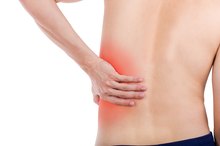I Have Pain Between the Shoulder Blades After a 30-Minute Walk
A number of factors can contribute to the pain you’re feeling between your shoulder blades after a walk, most of which aren’t cause for alarm. Muscular irritation and joint dysfunction are the likeliest of culprits, but other conditions can also lead to this type of discomfort. Talk to a doctor to determine the exact cause of your pain. If symptoms are severe, seek emergency treatment.
Irritation
Irritation to the muscles of your upper back is probably the most common cause of pain between the shoulder blades. Although fairly large muscles attach the shoulder blades to the thoracic spine, they’re quite prone to developing irritation, explains J. Talbot Sellers, a physiatrist with the NeuroSpine Center of Wisconsin. Even the slightest of postural changes can irritate muscle tissue and cause pain within the upper back. If, for example, you tend to look at the ground as you walk, the position of your neck can tighten the muscles of your upper back, which then leads to muscle irritation and subsequent pain between the shoulder blades.
- Irritation to the muscles of your upper back is probably the most common cause of pain between the shoulder blades.
- Although fairly large muscles attach the shoulder blades to the thoracic spine, they’re quite prone to developing irritation, explains J. Talbot Sellers, a physiatrist with the NeuroSpine Center of Wisconsin.
Dysfunction
Sacrum Pain While Pregnant
Learn More
Dysfunction along the joints that connect the ribs to your spine is also known to cause upper back pain. Normally, this connection adds stability to the upper back, which minimizes motion, notes Sellers. If any one of these joints isn’t functioning properly, the thoracic spine may move slightly with each step you take, which may cause unusual wear and tear to the discs or vertebrae of the thoracic back that leads to pain somewhere between the shoulder blades.
Irregularities
Skeletal irregularities can contribute to upper back pain as well. For example, if the curvature of your upper back is more exaggerated than normal, it can create a structural problem within the spine. Walking for an extended period of time may then exacerbate the issue and lead to pain between the shoulder blades.
Treatment
What Causes Pain When Performing Leg Raises?
Learn More
Treatment for this type of pain often depends on the cause, but most cases can be remedied by massage therapy, chiropractic care and pain medication. With massage therapy, muscle tension is manually released, which can help to alleviate the pain. Chiropractic care entails mobilizing the affected joint or joints to reduce discomfort. Pain relievers reduce discomfort while nonsteroidal anti-inflammatory drugs can reduce any inflammation caused by irritation of the muscles.
- Treatment for this type of pain often depends on the cause, but most cases can be remedied by massage therapy, chiropractic care and pain medication.
- With massage therapy, muscle tension is manually released, which can help to alleviate the pain.
Heart Attack
Pain between the shoulder blades is a potential symptom of a heart attack, particularly in women, according to the U.S. Health and Human Services Office on Women’s Health. This pain, however, is usually sharp in nature. It may also be accompanied by shortness of breath, cold sweats, fatigue, nausea, vomiting, dizziness and lightheadedness. If you experience one or more of these symptoms, especially when they are stronger or last longer than usual, call 911.
- Pain between the shoulder blades is a potential symptom of a heart attack, particularly in women, according to the U.S. Health and Human Services Office on Women’s Health.
Related Articles
References
- Spine-Health: All About Upper Back Pain
- National Institute of Health. MedlinePlus. Thoracic aortic aneurysm. Updated 04/27/17. https://medlineplus.gov/ency/article/001119.htm
- Fennell J, Phadke CP, Mochizuki G, Ismail F, Boulias C. Shoulder Retractor Strengthening Exercise to Minimize Rhomboid Muscle Activity and Subacromial Impingement. Physiother Can. 2016;68(1):24-8. doi:10.3138/ptc.2014-83
- Mitchell C, Adebajo A, Hay E, Carr A. Shoulder pain: diagnosis and management in primary care. BMJ. 2005;331(7525):1124-8. doi:10.1136/bmj.331.7525.1124
- Devon HA, Noureddine S. 20 things you didn't know about women and heart disease. J Cardiovasc Nurs. 2014;29(5):384-5. doi:10.1097/JCN.0000000000000129
- Sultan HE, Younis el-tantawi GA. Role of dorsal scapular nerve entrapment in unilateral interscapular pain. Arch Phys Med Rehabil. 2013;94(6):1118-25. doi:10.1016/j.apmr.2012.11.040
- Fukui T - J Intensive Care (2018) Management of acute aortic dissection and thoracic aortic rupture. doi:10.1186/s40560-018-0287-7
- Klumpner, T., Toledo, P., Wong, C., and J. Farrer. Interscapular Pain Associated with Neuraxial Labour Analgesia: A Case Series. Canadian Journal of Anaesthesia. 2016. 63(4):475-9. doi:10.1007/s12630-015-0540-7
- Sultan, H., and G. Younis-El-Tantawi. Role of dorsal scapular nerve entrapment in unilateral interscapular pain. Archives of Physical Medicine and Rehabilitation. 2013. 94(6):1118-25. doi:10.1016/j.apmr.2012.11.040
- National Institute of Health. MedlinePlus. Thoracic aortic aneurysm. Updated 04/27/17.
Writer Bio
Based in Minneapolis, Minn., Dana Severson has been writing marketing materials for small-to-mid-sized businesses since 2005. Prior to this, Severson worked as a manager of business development for a marketing company, developing targeted marketing campaigns for Big G, Betty Crocker and Pillsbury, among others.









